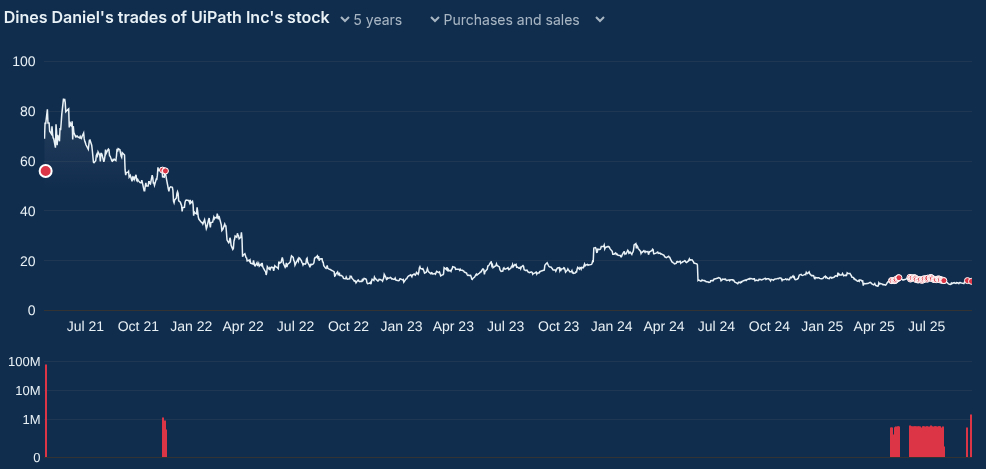UiPath at a Crossroads
Following UiPath's latest earnings call, management painted a picture of optimism. However, a deeper dive into the company's position reveals a more complex reality. While the leadership's confidence is noted, the data suggests UiPath (NYSE: PATH) is struggling to reignite growth and maintain its relevance in the rapidly evolving landscape of Generative AI. For some investors, the narrative from the top seems disconnected from the challenges seen on the ground.
The Shrinking Kingdom: GenAI's Double-Edged Sword
The wave of Generative AI is not just a buzzword; it's a fundamental shift that is reshaping the software industry. For UiPath, this presents a critical threat, no matter how the management wants to present it. Companies across the tech spectrum are now infusing GenAI capabilities directly into their platforms, automating tasks that once might have required a dedicated solution like UiPath. This trend is effectively diminishing the Total Addressable Market (TAM) for standalone automation platforms.
A simple example is the recent suite of products unveiled by Box, Inc. (NYSE: BOX) at its BoxWorks conference. Offerings like Box Extract for data extraction and Box Automate for native workflow automation leverage GenAI to handle tasks that are squarely in UiPath's traditional domain. Box is not an outlier; it is a representation of a broader movement where enterprise software providers are embedding automation directly, making it a feature rather than a separate platform. This leaves UiPath in a precarious position, needing to prove its value beyond what is becoming a commoditized capability.
The Defensible Core: A Moat, But Is It Wide Enough?
This is not to say UiPath is without its strengths. The company retains a defendable core in orchestrating complex, cross-stack, and policy-heavy processes. These are the mission-critical workflows that must coordinate humans, AI agents, and legacy robotic process automation (RPA) across multiple vendors and systems. Think of a bank processing a loan application, which requires navigating regulations, accessing mainframe data, and coordinating multiple departments.
In such environments, particularly in highly regulated industries like finance and healthcare, UiPath's platform provides essential governance, auditability, and reliability that newer, less mature solutions cannot match. This niche is UiPath's fortress. The critical question, however, is whether this fortress is a launchpad for future growth or simply a bastion to defend. From my perspective, these core use cases, while valuable, are not sufficient to reignite the significant growth trajectory that investors have been waiting for. The company needs something more, a new catalyst that is not yet visible in its financial metrics.
The Metrics That Matters: Net New ARR
To cut through the noise of management commentary, an important metric to watch for UiPath is the evolution of its Net New Annual Recurring Revenue (ARR). This figure represents the lifeblood of a SaaS company—the net value of new contracts signed in a quarter. It is the purest indicator of business momentum.
As the table below illustrates, the trend is concerning.
| Fiscal Qtr | Quarter End | Net New ARR ($m) |
| Q2 FY2026 | Jul 31, 2025 | 31 |
| Q1 FY2026 | Apr 30, 2025 | 27 |
| Q4 FY2025 | Jan 31, 2025 | 60 |
| Q3 FY2025 | Oct 31, 2024 | 56 |
| Q2 FY2025 | Jul 31, 2024 | 43 |
| Q1 FY2025 | Apr 30, 2024 | 44 |
| Q4 FY2024 | Jan 31, 2024 | 86 |
| Q3 FY2024 | Oct 31, 2023 | 70 |
| Q2 FY2024 | Jul 31, 2023 | 59.0 |
| Q1 FY2024 | Apr 30, 2023 | 45.0 |
| Q4 FY2023 | Jan 31, 2023 | 93.8 |
| Q3 FY2023 | Oct 31, 2022 | 66.8 |
The data shows significant volatility and a clear deceleration. The most recent quarters (Q1 and Q2 of Fiscal Year 2026) show Net New ARR figures of just $27 million and $31 million, respectively—a stark drop from the $86 million and $93.8 million seen in the fourth quarters of the preceding fiscal years. This is not the picture of a business re-accelerating; it's the picture of a business facing significant headwinds.
A Question of Confidence: Founder Stock Sales at Depressed Multiples
Adding another layer of concern is the recent pattern of stock sales by founder and CEO, Daniel Dines. Beginning in May 2025, Dines has been a continuous seller of UiPath stock. While these sales are executed under a pre-arranged Rule 10b5-1 plan, the timing is curious.

The company went public in April 2021, and Dines could have sold shares at much higher, post-IPO valuations. Why begin a consistent selling program now, a year after retaking the CEO role and with the stock's valuation significantly depressed? While personal financial planning can certainly be a factor, an investor cannot help but wonder about the signal this sends. The pattern raises questions about the CEO's confidence in the company's ability to navigate its current challenges and achieve a significant re-valuation in the near future.
In conclusion, while UiPath's management maintains a positive outlook, the underlying evidence calls for caution. The competitive landscape is intensifying due to the broad adoption of GenAI, the company's core defensible market may not be large enough to drive high growth, and the most critical growth metric, Net New ARR, is flashing warning signs. Combined with the optics of consistent insider selling from the founder, the investment case for UiPath remains challenging until a clear, data-backed turnaround emerges.